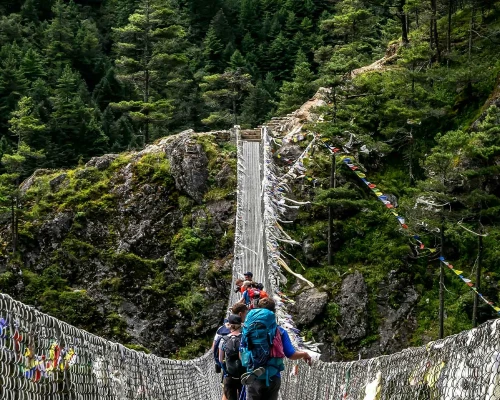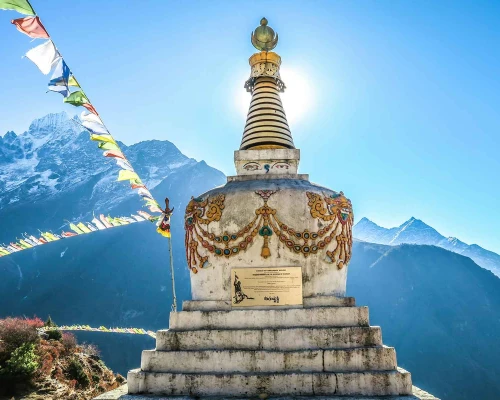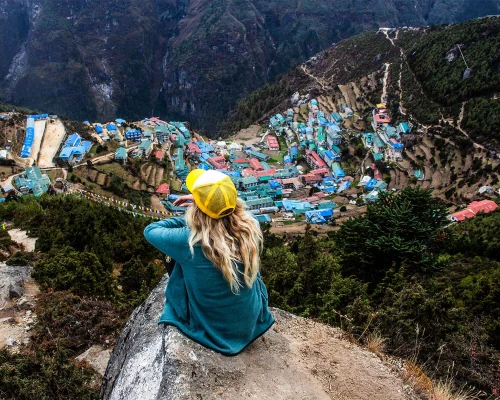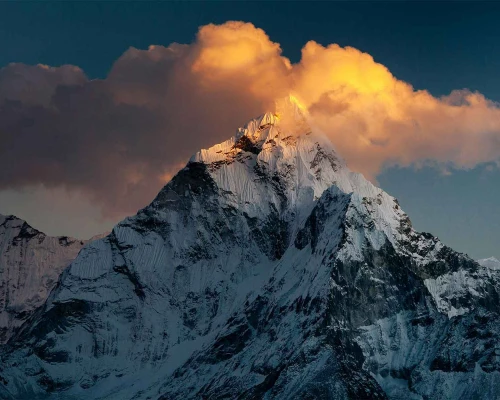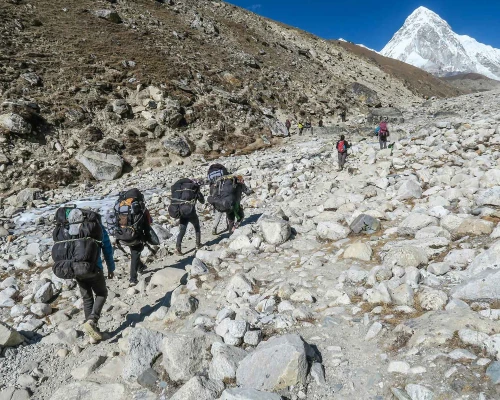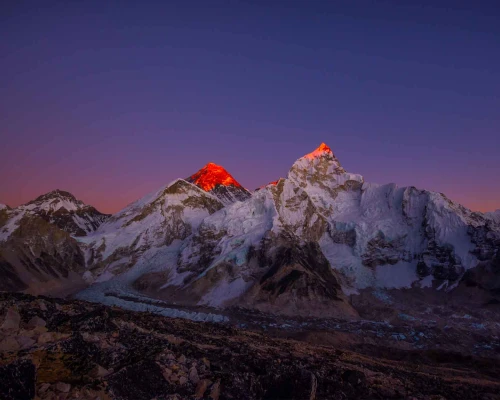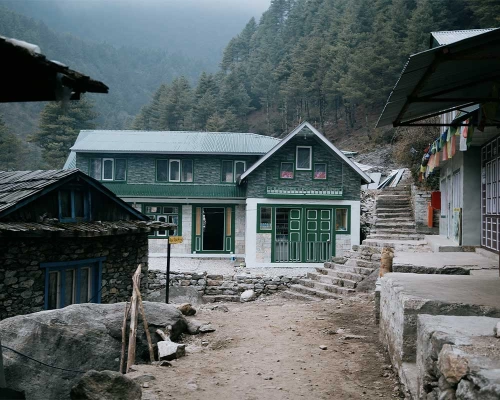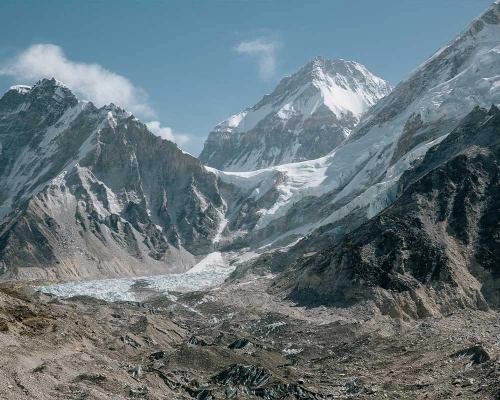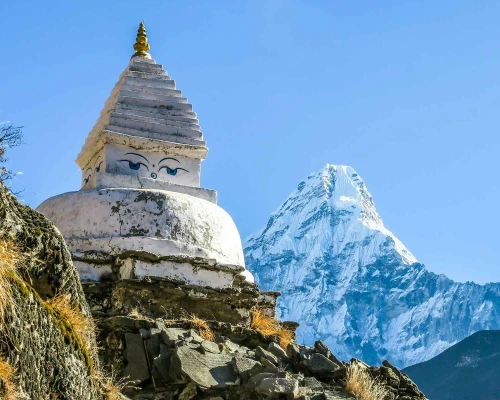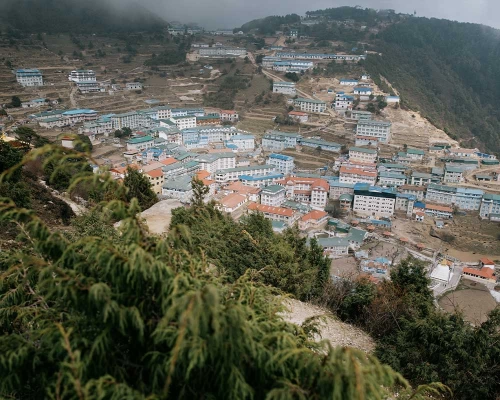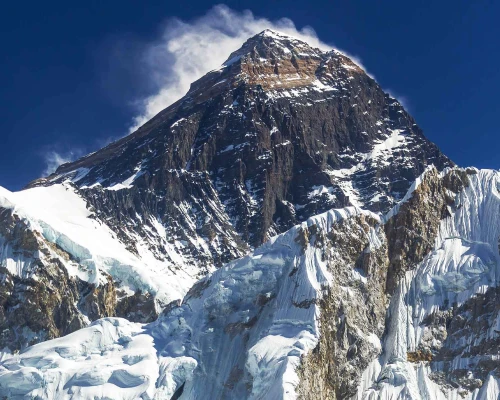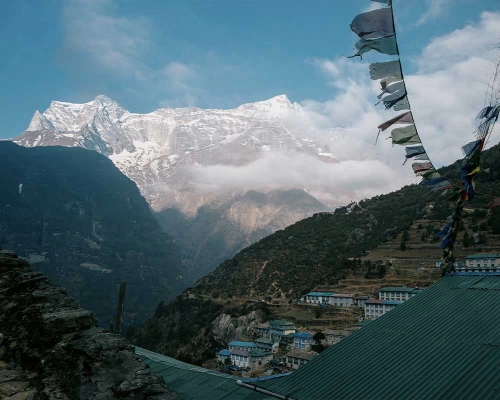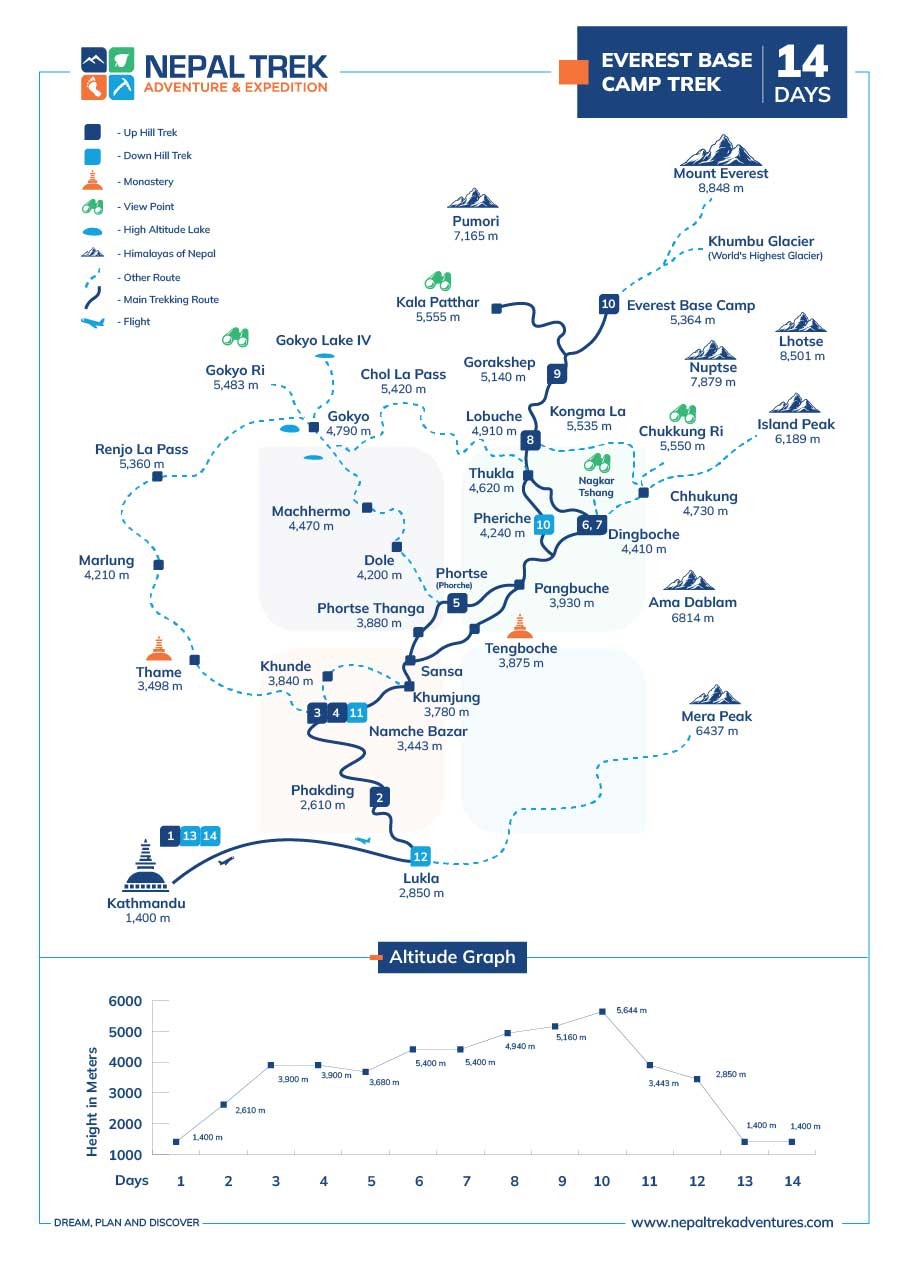Everest base camp trek is a high-altitude, adventurous trekking in Nepal. The Everest journey starts in Kathmandu with a flight to Lukla and reaches up to the base camp, Khumbu glaciers, and Kalapathar. Trekking to Everest offers a unique opportunity to experience the rich culture of the Sherpa people and witness the breathtaking views of Mount Everest and the Himalayas.
Everest base camp trek, known as the EBC Trek in short form, is the perfect adventure package for mountain and nature lovers. And especially for those who want to be surrounded by the Himalayas. Our journey begins from the valley of rich culture to the whole new world of Sagarmatha National Park. During the EBC trekking, we will be able to experience adventure, tranquility, culture, tradition, and nature.
14 days Everest base camp trek is one of the world's most popular odysseys, attracting thousands of adventure tourists annually. The Base camp trekking trail lies in Khumbu, Nepal (also known as the Everest Region). The route to the base camp site and back is about 300 km (186 miles) long and takes about 12 to 14 days to complete, including a scenic flight to Lukla and return.
The highest view point, Kala Patthar, aka Black Rock, situated at 5,645m (18,519 ft) above sea level, is one of the best highlight's of the Everest 14 days excursion. This trip provides us with the best view of Mount Everest, Nuptse, and a "once in a lifetime experience.". Mt. Nuptse is also known as the “Tibetan West Peak," and it is situated 2 km (1.2 mi) west-southwest of Everest.
The Everest base camp trip is a symbol of conquering a different perspective on life by getting away from the hustle and bustle of everyday life. Apart from all this, it’s an opportunity to learn about the real warriors who make it to the highest point on Earth.
Trekking to Mount Everest base camp in Nepal is the adventure path to the Goddess of the Sky. The name "Everest" is known as Chomolungma Peak in Tibet and Mount Sagarmatha in Nepal, which means "the Head in the Great Blue Sky," derived from Sagar, meaning "sky," and Matha, meaning "head."
The route that was used by Edmund Hillary and Tenzing Norgay to reach the top of Mount Everest in 1953 is the southeast ridge route to Accent. They accented the summit via the same route (the South Col route) at 11:30 local time on May 29, 1953. This trail is easier to ramble and not as technically difficult as the northern side.
Why Everest Base Camp Trekking Experience with Nepal Trek Adventures
- Our Simple and safe online booking system with our certified NTA tour operators with fluent English.
- We offer Trip postponement services with flexible itineraries based on the needs and preferences of the client.
- We provide packages that include all transportation (in a private or public vehicle, as requested by the client).
- We will experiencean an amazing flight to Tenzing-Hillary Airport, Lukla, exploring Sherpa people, traditions, culture, lifestyle, and staying at local tea houses.
- Trekking trail runs over the border of Sagarmatha National Park, a recreational center that extends over a wide range of geographical and altitudinal districts and is enhanced by an array of vegetation and fauna.
- Lukla, Namche Bazaar, is the gateway to the high Himalayas and the main trading center of the Khumbu region.
- Pass through the religious Tengboche community while trekking to Everest base camp.
- We provode amazing trip to Everest Base Camp with our certified NTA Trek Guide with fluent English
- Trek to Kala Patthar for a viewpoint of Mount Everest, a stunning sunrise view, Khumbu Icefall, and a glacier.
- Trekking route covered with rhododendron, pine, and oak forest, terraced fields, meadows, pastureland, bridges, monasteries, museums, library, laboratories, wilderness, etc.
Everest Base Camp Trek Costs for 2024, 2025, and 2026
The cost for the Everest base camp trek is $1295 per person for the years 2024, 2025, and 2026 from Kathmandu with us on a group joining basis. Our Everet trek price includes airport transfer, private transportation, Lukla flghts, guide and porters, accommodation, food, permits, and so on.
However, prices vary based on the type of trip (Private Trek and Group Joining), as well as the mode of payment (paying individually or in a group).
| No. of Person | Price Per Person |
| 1 pax | US $1550 |
| 2 to 4 pax | US $1450 |
| 5 to 10 pax | US $1295 |
| 11 to 15 Pax | US $1195 |
Note: The cost may also increase as per the requirement for additional services.
14 Days Everest Base Camp Trail Description
Everest Base Camp Trek, as you already know, is "one of the world's most iconic trekking routes.". This challenging yet rewarding adventure winds its way through the Khumbu Valley. Our trek starts from Lukla 2,619 m (8,593 ft), known gateway to Mount Everest. Lukla is the starting point for our hikes to Mount Everest base camp.From here, our ascent takes us to Namche Bazaar, "The Sherpa Capital.". Namche is the main trading center and popular trekker hub in the Khumbu region. It is an altitude-acclimatization stop in the high Himalaya.
Next, our path leads to Tengboche, a sacred Buddhist monastery situated at 3,860 meters (12,630 feet). Here, we can immerse ourselves in spiritual heaven. Tengboche monastery offers unique traditional beliefs of the Sherpa people. The Himalayan peaks seen from Tengboche are Tawache, Everest, Nuptse, Lhotse, Ama Dablam, and Thamserku, among many more.
Tenzing Norgay was born in the nearby village of Thani. He was the first man to summit the peak of Mount Everest with Sir Edmund Hillary. Norgay became a monk at Tengboche Monastery. After spending a day in Tengboche, our next destination is Dingboche Camp.
Dingboche stands at an elevation of 4,410 m (14,470 ft) in the Khumbu region of Nepal. Our 14 days Everest base camp trek will pass through Dingboche village. It serves as our second base for acclimatization. The climate of Dingboche is tundra (ET), according to Köppen. The climate has cool summers with heavy rains and dry, frigid winters, influenced mostly by the altitude and the summer monsoon.

The best periods to go Everest trekking are in the spring (March and April) or fall (October and November). During these, the weather is mild and the mountains are visible. Recently, Mount Everest base camp trekking is also open, making it ideal to go trekking in the winter (December to February). As the higher camp, like Dingboche, Lobuche accommodates hikers. The Everest Trek in winter offers less crowded trails with valued customer care from local tea houses in the Solukhumbu region.
And then we head to Lobuche, in the Khumbu area of Nepal, Lobuche (also Lobuje) is a small village near the base of Mount Everest. Lobuche is one of the second-last overnight spots on the "trail to base camp" path to Everest Base Camp (South) on the southeast route.
Everest Base Camp and Hike to Kalapathar
Finally, we will reach Gorakshep, the last stop before the base camp. Gorakshep serves as the base for your final ascent to Everest Base Camp. It is situated at an elevation of 5,364 meters (17,598 feet) above sea level.
From there, our expedition team can summit the Everest base camp by foot. After the summit, we are going to Gorak Shep. The Dalai Lama called it "the steps to heaven." Lukla to Everest Base Camp hikes wrap up here. The next day, we hike to Kala Patthar (5,545 m, 18,192 ft) for a unique vista of Everest, and start decending to Lukla via Pheriche, Namche Bazzar, and Phakding.
Best Time for Trek to Everest Base Camp

The best time to do Everest Base Camp trek is from late September to November, March to May, and December to February. During these months, the weather is usually stable and the sky is clear, so you can see the mountains very well.
In autumn, the weather is mild and the days are sunny, which makes it a great time to go hiking. This time of year is also less busy than spring. In the spring season, the weather is warmer and the flora is in full bloom, which makes the scenery even more beautiful. But this is a popular time to hike, so the trails may be full of people. Winter is less crowded, but you still need extra layers of clothing.
If you are an adventurer looking for a once-in-a-lifetime experience, then Booking a Everest Base Camp Trek is definitely worth considering.
Ready to pack your bag on the adventure of a lifetime? Join us for an unforgettable trek to Everest Base Camp! Don't miss this opportunity to explore the roof of the world - book your trek today!
Is This EBC Trek Suitable For You?
The 14 days Everest base camp trek itinerary is designed to reduce the risk of altitude sickness by limiting daily altitude gain and scheduling an acclimatization period.
For proper rest, comfortable seating is required during the trek. In this itinerary, there are two acclimatization days: Namche Bazaar at an elevation of 3,450m (11,319ft) and Dingboche at an elevation of 4,410 m (14,470 ft) for adapting your bodies to the higher altitude.
Reaching the base camp of Mount Everest is a significant achievement that not many people get to experience. The trekkers contribute to the local economy, and the trekking companies promote responsible tourism, which is sustainable for the local people and their environment.
Starting from your arrival day at TIA in Kathmandu, Nepal, and the adventurious flight to Lukla, you’ll be hiking for six to seven hours daily, and the trail ascends and descends as it winds through countless side valleys, rough stony paths, and high-altitude mountain passes.
The trek to Everest base camp is suitable for all types of age groups, from children as young as 10 years up to 70-year-old men or women. Grab this opportunity and live your dream of hiking in the high mountains of the Everest region. For these reasons, you should be in good health and have physical and mental fitness before embarking on this trail.
If you are planning to go on the Everest base camp solo trek, it is highly recommended to hire a guide to ensure your safety and navigate the challenging terrain.
NTA Travel Tips for Mount Everest Base Camp Trip
- A good level of fitness is needed for the trek, so it's important to start training early.
- Focus on building your stamina by doing cardio and strength exercises.
- Altitude sickness is a real risk on the trek, so it's important to acclimate properly.
- Take your time to adjust to the altitude, and don't rush to higher elevations.
- The weather in the Himalayas can be unpredictable, so it's important to bring clothes that are warm and waterproof, as well as a good sleeping bag and a down jacket.
- Make sure you have all the right equipment and gear.
- Make sure to drink a lot of water and eat foods that are full of nutrients.
- If you want to do a solo Everest base camp trek, you should hire a guide or join a trekking group.
- Everest guides have the knowledge and experience to make sure the trek is safe and fun.
- Getting travel and medical insurance is a must for any trek in the Himalayas.
- Make sure that your policy covers medical care and evacuation in case of an emergency.
- Respect the local environment and culture.
- Carry trekking permits and necessary documentation
- Follow the Leave No Trace principles and don't litter or leave trash behind.
- Be ready for delays and problems that come up out of the blue.
- Be ready to adapt to changing situations and have a positive mentality.
Everest Base Camp Group Trek: Joining the Fixed Departures
14 days Everest base camp trek for group joining operates whether you are a single, double, trio, or are in any number. We provide a group joining facility with another group of strangers to complete the Everest base camp trip. The 14 days EBC trek includes 2 nights Hotel in Kathmandu, round-trip flight tickets, a guide, and a sharing 1 porter by every 2 guests.
This type of trek is referred to as a budget trek since it is less expensive than a private trek Everest luxury trek. Get in touch with us for more information as the cost of climbing Everest might slightly change.
Private Everest Base Camp Trek, 14 Days
The private trekking to Everest base camp means you will book the trip for your private team or family members. We provide everyday departure for those who book a private trip to Everest throughout the year. Traveling in a private group will provide an opportunity to make the journey as lavish as possible, with luxurious lodging, lavish meals, and other amenities at an additional cost.
Comparing the cost of the group joining the trek to the base camp of Everest, the private trek will ultimately be more expensive. Contact us with your requirements and for a detailed quotation.
Check out our useful information section to know about Everest Base Camp Trek. Or if you have more questions about the EBC Trek. Feel Free to TALK TO BINOD our Travel Expert
For Booking Check Availability
Book now and get free t-shirts, caps, and stickers.




